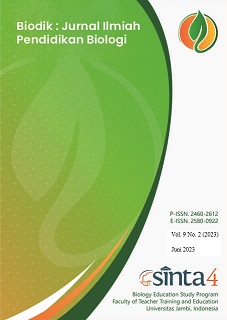Analisis Bibliometrik Perkembangan Riset Media Pembelajaran Biologi Berbasis Teknologi di SMA Menggunakan Vosviewer
(Bibliometric Analysis of the Development of Technology-Based Biology Learning Media Research in High School Using Vosviewer)
DOI:
https://doi.org/10.22437/biodik.v9i2.20906Abstract
The purpose of this study is to find out the development of research, the most productive researchers, research trends and research topics that have not been carried out. The source of the data in this study was obtained from the Google Scholar and Scopus websites. The data collection technique in this study used the Publish or Perish (PoP) application. Data analysis using bibliometric analysis assisted by Vosviewer. The results of bibliometric analysis produce 3 forms of data, namely Network Visualization showing the relationship between research topics, Overlay Visualization showing the renewal of a research and Density Visualization showing the number of research topics carried out. The results showed that the number of publications on technology-based biology learning media in high school in the period 2011-2021 always increased every year. The most productive researcher on technology-based Biology learning media is Ikhsan, J. who produced eight documents, Ichsan, Iz with seven documents. The topics of technology, development and learning are topics that are most often used together in Biology research articles or journals. The research topics that are the least carried out are on learning media in the form of applications, artificial intelligence, Augmented Reality and virtual environments.
Key words: Bibliometrics, Media, Technology, Vosviewer
Â
ABSTRAK
Tujuan penelitian ini adalah untuk mengetahui perkembangan riset, peneliti paling produktif, tren penelitian dan topik penelitian yang belum dilakukan. Sumber data dalam penelitian ini yaitu diperoleh dari website Google Scholar dan Scopus. Teknik pengumpulan data pada penelitian ini menggunakan aplikasi Publish or Perish (PoP). Analisis data dengan menggunakan analisis bibliometrik berbantu Vosviewer. Hasil analisis bibliomterik menghasil 3 bentuk data yaitu Network Visualization menampilkan keterkaitan antar topik penelitian, Overlay Visualization menampilkan keterbaharuan sebuah penelitian dan Density Visualization menampilkan banyaknya topik penelitian yang dilakukan. Hasil penelitian didapatkan bahwa jumlah publikasi tentang media pembelajaran biologi berbasis teknologi di SMA pada rentang waktu tahun 2011-2021 setiap tahunnya selalu mengalami kenaikan. Peneliti paling produktif tentang media pembelajaran Biologi berbasis teknologi adalah Ikhsan, J. menghasilkan delapan dukumen, Ichsan, Iz dengan tujuh dokumen. Topik technology, development dan learning merupakan topik yang  paling sering digunakan secara bersamaan dalam artikel atau jurnal penelitian Biologi. Topik penelitian yang paling sedikit dilakukan adalah tentang media pembelajaran dalam bentuk aplication, artificial intelegence, Augmented Reality dan virtual environment.
Kata kunci: Bibliometrik, Media, Teknologi, Vosviewer
Downloads
References
Aribowo, E. K. (2019). Analisis bibliometrik berkala ilmiah names: Journal of Onomastics dan peluang riset onomastik di Indonesia. Aksara, 31(1), 85.
Ayudha, C. F. H., & Setyarsih, W. (2021). Studi Literatur : Analisis Praktik Pembelajaran Fisika di SMA Untuk Melatih Keterampilan Pemecahan Masalah. Jurnal Pendidikan Fisika Undiksha, 11(1), 15–28.
Herlanti, Y. (2020). Trend Riset Pendidikan Biologi. Journal of Biological Education, 50(1), 3–6. https://doi.org/10.1080/00219266.2016.1140984
Ismail. (2021). Meta-Analisis Simulasi Virtual Dalam Pembelajaran Untuk Mendukung Berpikir Kritis. Bioscientist : Jurnal Ilmiah Biologi, 9(2), 666–674.
Karim, A., & Soebagyo, J. (2021). Pemetaan Bibliometrik Terhadap Trend Riset Matematika Terapan Di Google Scholar Menggunakan Vosviewer. Teorema: Teori Dan Riset Matematika, 6(2). https://doi.org/10.25157/teorema.v6i2.5835
Nisa, M., Setiati, N., & Nugrahaningsih, W. (2022). Development of Tour in Cell Interactive Media to Improve Cognitive Skills of High School Students. Journal of Biology Education, 11(1), 47–55.
PeranginAngin, R. B., Panjaitan, S., Hutauruk, A., Manik, E., & Tambunan, H. (2021). Arah dan Trend Penelitian Pendidikan Matematika di Jurnal Riset Pendidikan Matematika (JRPM). VYGOTSKY: Jurnal Pendidikan Matematika Dan Matematika Program Studi Pendidikan Matematika Fakultas Keguruan Dan Ilmu Pendidikan Universitas Islam Lamongan, 3(1), 49. https://doi.org/10.30736/voj.v3i1.340
Rahman, G., Nurfajriani, & Jahro, I. S. (2020). Tren penelitian pendidikan proses pembelajaran daring selama pandemi covid 19. Prosiding Seminar Nasional Kimia Berwawasan Lingkungan, 31–37.
Ristanto, R. H., Mahardika, R. D., & Rusdi. (2021). Digital flipbook immunopedia (DFI): A learning media to improve conceptual of immune system. IOP Conference Series: Earth and Environmental Science, 1796(1). https://doi.org/10.1088/1742-6596/1796/1/012066
Tupan, T., Rahayu, R. N., Rachmawati, R., & Rahayu, E. S. R. (2018). Analisis Bibliometrik Perkembangan Penelitian Bidang Ilmu Instrumentasi. Jurnal Dokumentasi Dan Informasi, 39(2), 135. https://doi.org/10.14203/j.baca.v39i2.413
Zed, M. (2004). Metode Penelitian Kepustakaan. Yayasan Obor Indonesia.
Zubaidah, S. (2018). Trend Penelitian Pendidikan Biologi. Kuliah Tamu UIR, April, 1–8.
Downloads
Published
How to Cite
Issue
Section
License
Copyright (c) 2023 Ihwan Fauzi Saputra, Bambang Hariyadi, Evita Anggereini

This work is licensed under a Creative Commons Attribution-NonCommercial-ShareAlike 4.0 International License.
Copyright Notice
Authors who publish with Biodik : Jurnal Ilmiah Pendidikan Biologi agree to the following terms:
- For all articles published in Biodik : Jurnal Ilmiah Pendidikan Biologi, copyright is retained by the authors and grant the journal right of first publication with the work simultaneously licensed under a Creative Commons Attribution-ShareAlike 4.0 International Licensethat allows others to share the work with an acknowledgment of the work's authorship and initial publication in this journal.
- Authors are able to enter into separate, additional contractual arrangements for the non-exclusive distribution of the journal's published version of the work (e.g., post it to an institutional repository or publish it in a book), with an acknowledgment of its initial publication in this journal.
- Authors are permitted and encouraged to post their work online (e.g., in institutional repositories or on their website) prior to and during the submission process, as it can lead to productive exchanges, as well as earlier and greater citation of published work (See The Effect of Open Access).
















